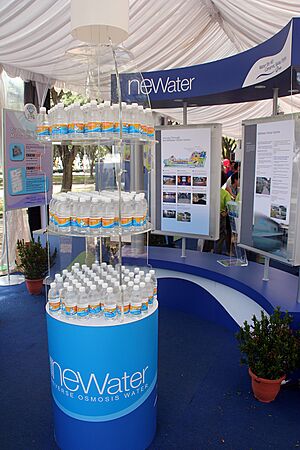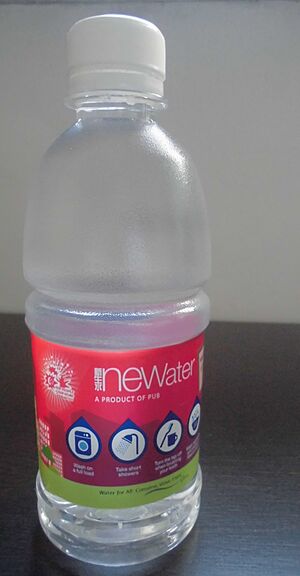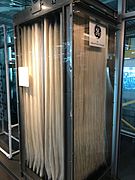NEWater facts for kids

NEWater is the brand name for used water that has been cleaned using advanced technology in Singapore. It is produced by Singapore's Public Utilities Board (PUB).
The process to create NEWater is very thorough. First, used water from homes and businesses is collected and treated. Then, this treated water goes through three more high-tech cleaning steps: microfiltration, reverse osmosis, and ultraviolet light treatment.
The result is water that is super clean and safe to drink. Some of this water is added to Singapore's reservoirs, where it mixes with rainwater before being treated again and supplied to homes. However, most NEWater is used by factories that need very pure water for making things like electronics.
Contents
Why Singapore Created NEWater
In the 1970s, Singapore began looking for new ways to get fresh water. The country is a small island and doesn't have many natural water sources. For a long time, Singapore had an agreement to buy water from its neighbor, Malaysia. However, Singapore wanted to have its own reliable water supply for the future.
In 1998, the government started a serious study to see if recycling water was a good solution. They found that with modern technology, they could turn used water into high-quality clean water. This project was named NEWater.
Getting People On Board
When NEWater was introduced to the public in 2003, the government knew that some people might be worried about drinking recycled water. To help everyone understand how safe it was, they launched a big educational campaign.
They were careful with their words, calling it "used water" instead of "wastewater." They also opened the NEWater Visitor Centre, where people could see the cleaning process for themselves. This helped build public trust and support for the project.
How NEWater is Made
Singapore has several NEWater plants that work around the clock to produce clean water. The first plants opened in Bedok and Kranji in 2002. More plants were later built in Ulu Pandan and Changi to meet the country's growing needs.
There is a Visitor Centre at the Bedok plant where you can learn all about NEWater. It has won awards for being a great educational experience. The centre offers fun programs for students, like becoming a "NEWater Scientist" for a day or learning how to be a "Water Ambassador."
The Three-Step Cleaning Process
The water used to make NEWater has already been treated once. It then goes through three more powerful cleaning stages to become ultra-clean.
- Microfiltration: In the first step, the water is pushed through special filters with tiny pores. These filters trap small particles, bacteria, and some viruses. Think of it like a super-fine strainer.
- Reverse Osmosis (RO): Next, the water goes through an even more advanced filtering process called reverse osmosis. The water is forced through a special membrane that blocks almost everything else, including dissolved salts and the smallest viruses. Only water molecules can get through. After this step, the water is clean enough to drink.
- Ultraviolet (UV) Disinfection: As a final safety step, the water is zapped with powerful ultraviolet light. This UV light makes sure that any remaining germs are completely inactivated. A few chemicals are then added to balance the water's pH level before it's ready to be used.
- The NEWater Production Process
NEWater Plants in Singapore
This table shows the main NEWater plants and how much water they can produce.
| Plant name | Location | Date of commissioning | Current capacity (Per Day) | Operator |
|---|---|---|---|---|
| Bedok NEWater Factory | Bedok | 2002 | 19 million imperial gallons (86,000 m3) | PUB |
| Kranji NEWater Factory | Kranji | 2002 | 12 million imperial gallons (55,000 m3) | PUB |
| Seletar NEWater plant | Seletar | 2004 | Decommissioned in 2011 | PUB |
| Keppel Seghers NEWater Plant | Ulu Pandan | 2007 | 33 million imperial gallons (150,000 m3) | Keppel Seghers |
| Sembcorp NEWater Plant | Changi | 2010 | 50 million imperial gallons (230,000 m3) | Sembcorp |
| BEWG-UESH NEWater Plant | Changi | 2017 | 50 million imperial gallons (230,000 m3) | BEWG-UESH |
How is NEWater Used?
Most of the NEWater produced is used by industries, especially those that make computer chips and other electronics. These factories need water that is even purer than regular tap water, and NEWater is perfect for the job.
A small amount of NEWater is also pumped into Singapore's reservoirs. There, it mixes with rainwater and goes through the standard water treatment process before flowing to people's homes as tap water. This is called indirect potable use.
Currently, NEWater can meet about 40% of Singapore's water needs. The goal is to increase this to 55% by the year 2060.
How Clean is NEWater?
NEWater is extremely clean and safe. Its quality is regularly tested and it passes the strict standards set by the World Health Organization (WHO) and the United States Environmental Protection Agency (USEPA). In fact, it is often cleaner than other sources of tap water.
The table below shows how NEWater's quality compares to international standards.
| Water Quality Parameters | NEWater | USEPA /WHO Standards |
|---|---|---|
| A) Physical | ||
| Turbidity (NTU) | <5 | 5/5 |
| Colour (Hazen Units) | <5 | 15/15 |
| Conductivity (μS/cm) | <250 | Not Specified |
| pH Value | 7.0–8.5 | 6.5–8.5 |
| Total Dissolved Solids (mg/L) | <150 | 500/1000 |
| Total Organic Carbon (mg/L) | <0.5 | -/- |
| Total Hardness (CaCO 3)(mg/L) |
<50 | Not Available |
| B) Chemical (mg/L) | ||
| Ammoniacal nitrogen (as N) | <1.0 | -/1.2 |
| Chloride (Cl) | <20 | 250/250 |
| Fluoride (F) | <0.5 | 4/1.5 |
| Nitrate (NO 3) |
<15 | 10/11 |
| Silica (SiO 2) |
<3 | -/- |
| Sulphate (SO 4) |
<5 | 250/250 |
| Residual Chlorine (Cl, Total) | <2 | 4/5 |
| Total Trihalomethanes (as mg/L) | <0.08 | 0.08/- |
| C) Metals (mg/L) | ||
| Aluminum | <0.1 | 0.05–0.2/0.2 |
| Barium | <0.1 | 2/0.7 |
| Boron | <0.5 | -/0.5 |
| Calcium | 4 - 20 | -/- |
| Copper | <0.05 | 1.3/2 |
| Iron | <0.04 | 0.3/0.3 |
| Manganese | <0.05 | 0.05/0.4 |
| Sodium | <20 | -/200 |
| Strontium | <0.1 | -/- |
| Zinc | <0.1 | 5/3 |
| D) Bacteriological | ||
| Total Coliform Bacteria (Counts/100 mL) | Not detectable | Not detectable |
| Enterovirus | Not detectable | Not detectable |
| Heterotrophic Plate Count (CFU/mL, 35 °C, 48 h) | <300 | <500/- |
See also
- Water supply and sanitation in Singapore











